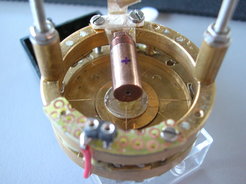Development of a Faraday magnetometer based on piezoresistors for very high magnetic fields

Material development and new measurement techniques have been very often behind important discoveries in physics. The Faraday force magnetometer is one of these examples [1]: It measures the force exerted on a magnetic material with magnetization M situated in a spatially varying magnetic field dB/dz, according to the simple relation F = (M·Δ)B. This technique allows a very precise measurement of the magnetization at very low temperature and high magnetic field since the sample can be kept at the lowest temperature, e.g. some milliKelvin, inside the magnet. The force can be measured capacitively with the help of modern ultra-precision capacitance bridges. However, this technique is usually limited to standard continuous superconducting DC magnets and relatively large capacitance plates. Therefore, it is only possible to measure in fields up to about 20 Tesla. Nowadays pulse magnets can reach magnetic fields up to about 90 T, as those fabricated and used at the High Magnetic Field Laboratory in Rossendorf (Dresden, Germany). One way to combine the Faraday method with the use of small samples and very high fields is to use commercial membrane-type surface-stress sensors which are piezoresistive nanomechanical sensors [2]. These sensors are very small (2 mm) and very sensitive to vertical sample displacement that can be easily induced on a magnetic material with a gradient field. Even without gradient field it is possible to measure the torque of the sample which is proportional to the magnetization perpendicular to the applied field. This has been already used, for instance, by Takahashi et al. to obtain high-resolution measurements of quantum oscillations in Sr2RuO4 at 1.5 K and up to 15 T [3].
Our project is a collaboration between the groups of M. Brando at the Max Planck Institute for Chemical Physics of Solids in Dresden (http://www.cpfs.mpg.de/) and J. Wosnitza at the High Magnetic Field Laboratory in Rossendorf (https://www.hzdr.de/hld). The successful applicant will develop a Faraday magnetometer based on piezoresistors for DC and pulse fields and measure quantum oscillations of recently discovered exotic metals.
References












